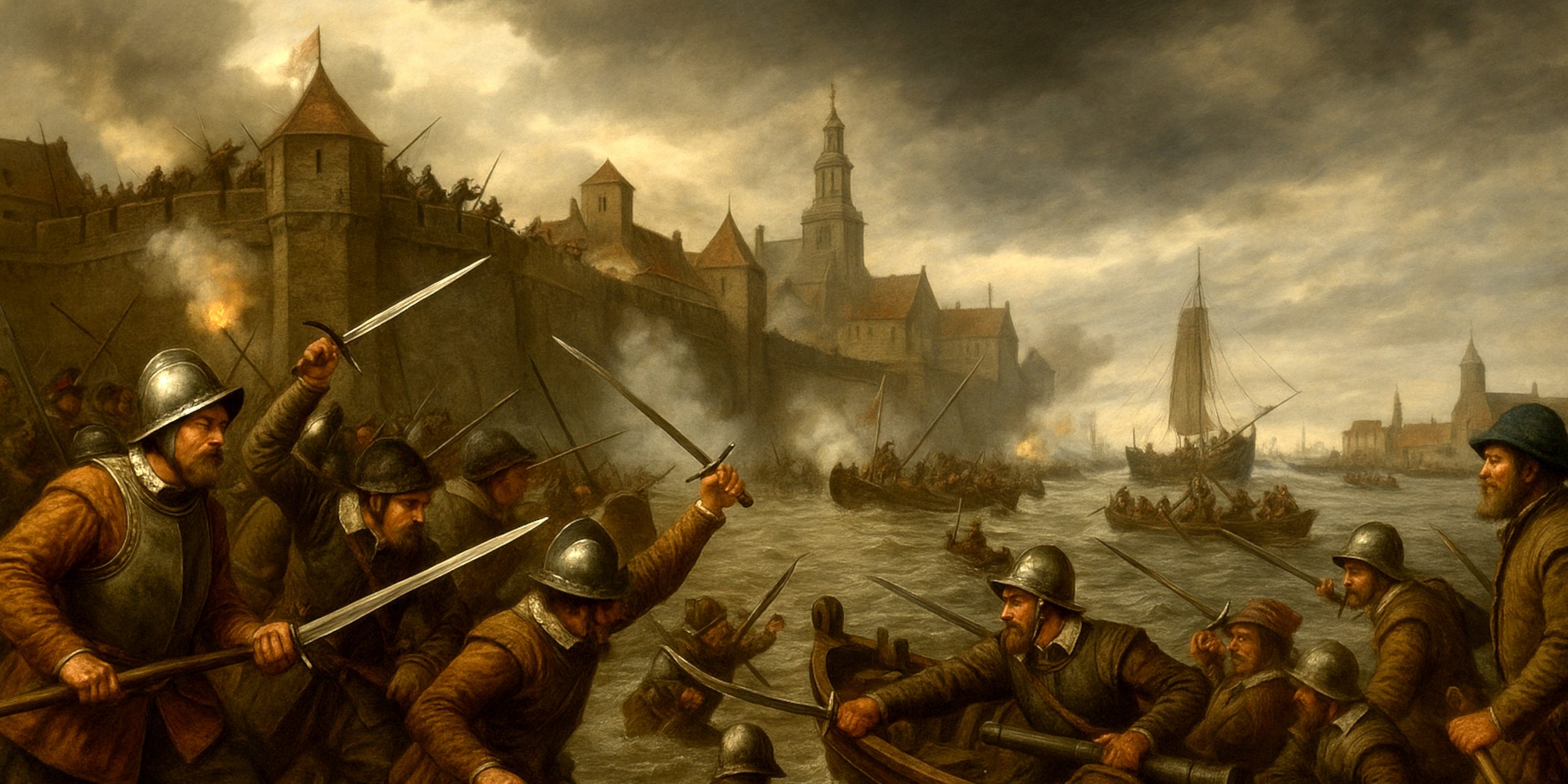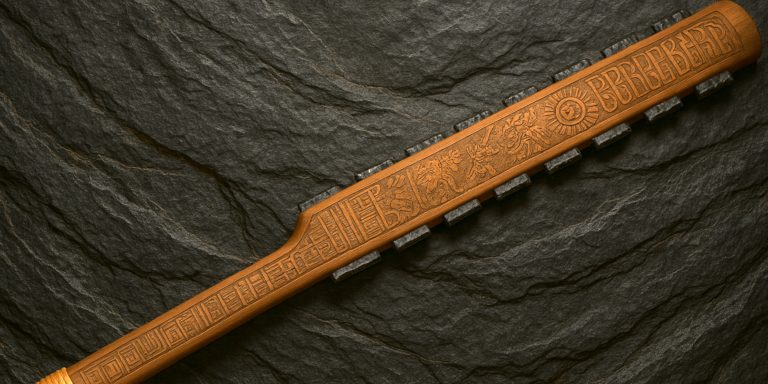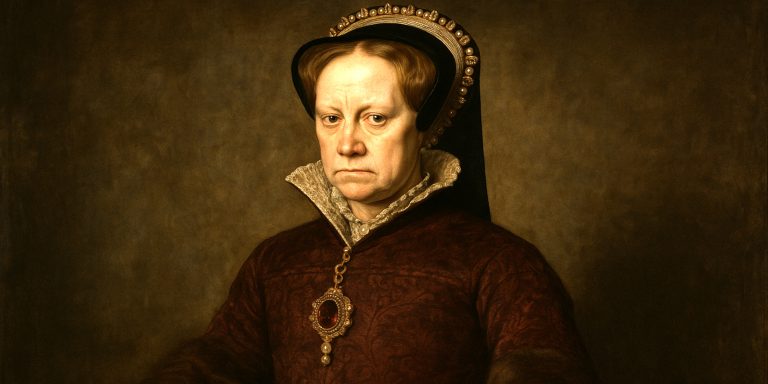
The Siege and Battle of Leiden (1573–1574) stands as one of the defining moments of the Dutch Revolt, or Eighty Years’ War. It was not a single clash of arms in an open field, but a drawn-out test of endurance, ingenuity, and sheer Dutch obstinacy. Against the might of the Spanish Empire, Leiden held out under siege for months, famine, plague, and betrayal gnawing at its walls, until the waters themselves became the city’s salvation.
It is one of those rare moments in history when geography, weather, and human will conspired to deliver something resembling divine justice.
Background
By 1573, the northern provinces of the Netherlands were in open revolt against Spanish rule under Philip II. Leiden, a prosperous textile centre, declared for William of Orange. The Spanish commander Francisco de Valdez responded with the classic Habsburg approach: siege it, starve it, and if necessary, annihilate it.
The first siege failed in 1573 after Spanish forces were recalled to confront rebel activity elsewhere. The second, beginning in May 1574, was far more methodical. Leiden’s citizens, numbering about 18,000, endured near starvation while Spanish troops ringed the city with earthworks and redoubts.
William of Orange, recovering from illness, ordered the deliberate breaching of the dykes, flooding the polders to turn the flat Dutch countryside into a watery battlefield. It was an audacious plan, one only a people accustomed to living below sea level could dream up.
Forces
| Side | Commanders | Estimated Strength | Composition |
|---|---|---|---|
| Dutch Rebels (Sea Beggars & Leiden Militia) | Louis Boisot (Admiral of the Sea Beggars), Jan van der Does (City Commander), William of Orange (strategic leader) | 6,000–8,000 (relief force and local militia) | Armed citizenry, mariners, civic guards, a few companies of mercenaries |
| Spanish Empire | Francisco de Valdez | 8,000–10,000 | Veteran tercios, German and Walloon infantry, artillery units |
The Spanish were disciplined, methodical, and very good at building siege works. The Dutch had boats, pikes, rusty swords, and an unholy desire not to die under Spanish taxation.
Arms and Armour
Dutch Forces
- Weapons:
- Armour:
- Buff coats and breastplates among the militia
- Sea Beggars often wore simple leather jerkins or sailors’ gear; chain shirts were rare due to the waterborne nature of the relief effort
Spanish Forces
- Weapons:
- Long pikes, halberds, and swords typical of the Spanish espada ropera type
- Harquebuses and culverins for siege bombardment
- Armour:
- Morion helmets, breastplates, tassets; full plate was rare by this stage
- Officers carried finely made Toledo blades, straight and deadly, often more a mark of social standing than practical necessity in the mud of the Low Countries
The Battle (and Flood)
The Spanish, confident of victory, found themselves outmanoeuvred by hydrology. In late September 1574, the dykes were breached, and a combination of storm tides and deliberate flooding transformed the lowlands into a shallow sea.
The Dutch “Sea Beggars” sailed over what had been farmland, their ships carrying supplies, soldiers, and cannon. Spanish camps dissolved into chaos as trenches filled with water and gunpowder went soggy.
On 3 October 1574, after months of starvation and failed assaults, the relief fleet finally reached Leiden. Spanish forces, unable to hold their positions in the rising water, retreated. Citizens opened the gates and were met not by soldiers in shining armour, but sailors bearing herring and white bread, luxuries beyond imagining after the hunger.
The city rang its bells and celebrated survival, not triumph. Contemporary accounts describe people weeping as they ate.
Archaeology and Material Finds
Modern archaeology in Leiden has unearthed remnants from the siege period:
- Cannonballs embedded in old foundations near the city gates
- Domestic refuse showing dietary collapse: animal bones, weeds, and even leather scraps, evidence of desperate consumption
- Fragments of swords and armour consistent with both local militia and Spanish issue
- Commemorative tokens and medals minted after the siege, celebrating Leiden’s endurance
The flooding strategy left little in the way of traditional battlefield remains; most artefacts were reclaimed from within the city itself. The siege earthworks, long since buried under urban expansion, survive only in maps and the occasional archaeological trench.
Timeline of Events
| Date | Event |
|---|---|
| October 1573 | First Spanish siege lifted after William of Orange’s manoeuvres force withdrawal |
| May 1574 | Second siege begins; Spanish forces encircle Leiden |
| July 1574 | Famine and disease ravage the city; William orders dykes cut |
| August–September 1574 | Floodwaters rise; Spanish camps begin to falter |
| 2 October 1574 | Storm surge deepens flood; Sea Beggar fleet nears Leiden |
| 3 October 1574 | Relief fleet enters the city; Spanish withdraw |
| 4 October 1574 | Thanksgiving service held; Leiden survives |
Contemporary Voices
“Better a city destroyed than ever again enslaved.”
William of Orange, addressing Leiden’s defenders
“We saw the ships, like angels upon the waters, and the people fell upon their knees.”
Leiden diarist, 1574
“God sent the wind, and the sea obeyed.”
Chronicler Emanuel van Meteren
Dry observers might point out that divine intervention looked suspiciously like clever engineering. Still, if one must choose between God and a Dutchman with a shovel, bet on the latter.
Aftermath and Legacy
The victory at Leiden was a turning point in the Dutch Revolt. In gratitude, William of Orange founded Leiden University in 1575, a reward for the city’s loyalty. It remains one of the oldest universities in the Netherlands, a symbol of knowledge triumphing where brute force failed.
The Spanish never quite recovered their aura of invincibility. The siege demonstrated that Dutch resilience, ingenuity, and the occasional act of deliberate flooding could withstand one of Europe’s most formidable armies.
As historical irony goes, the city that nearly drowned was saved by water.
The Seven Swords Takeaway
The Battle (or more accurately, the deliverance) of Leiden reveals the peculiar genius of Dutch resistance. Where others relied on cavalry charges or divine inspiration, they relied on sluices, tides, and a stubborn refusal to surrender. In a landscape shaped by water, the people learned to make it their ally.
And when the Spanish came with swords, the Dutch simply reached for the floodgates.



